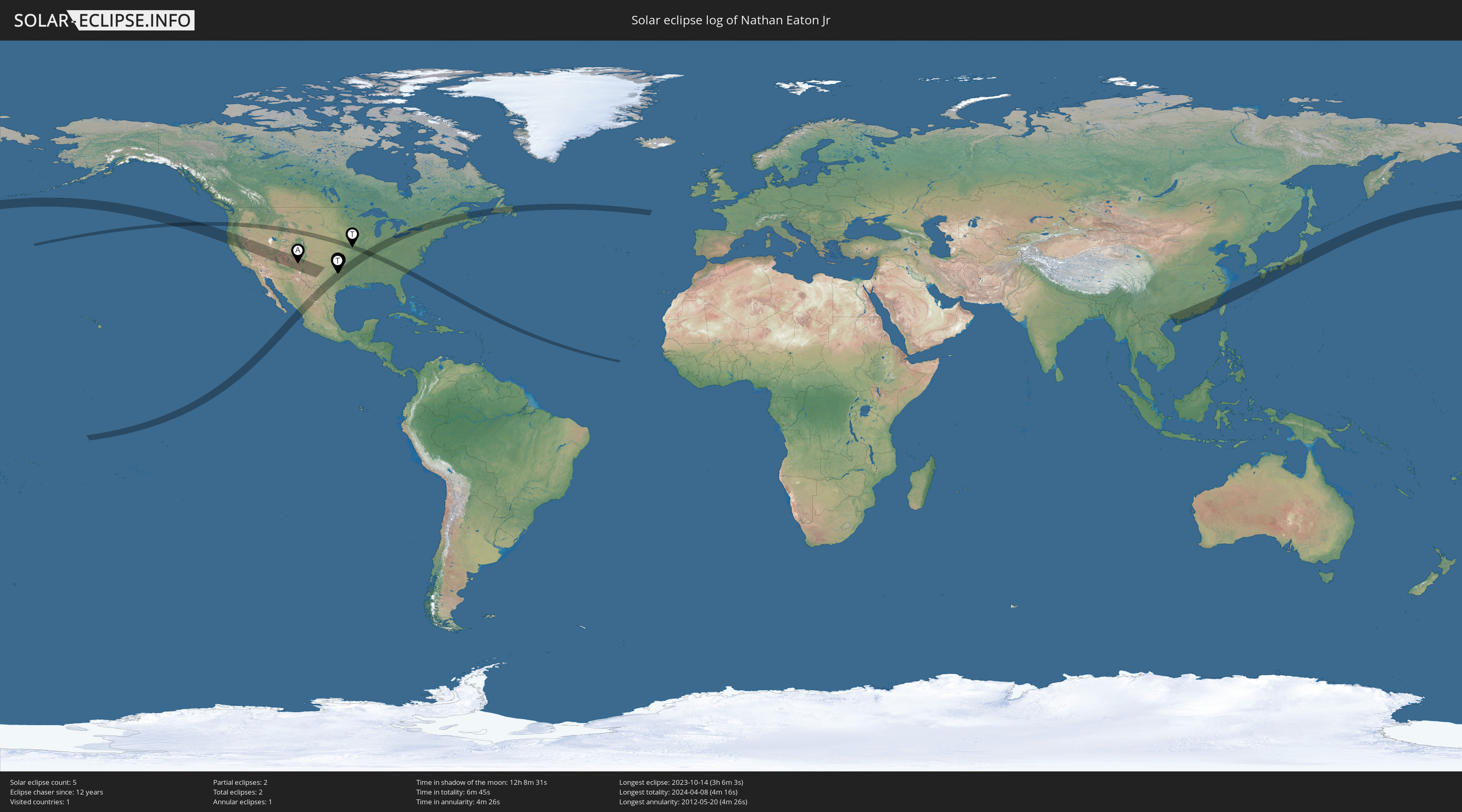Why would that matter? If your primary interest is being able to see the entire eclipse, start to finish, then there's no surer bet than a night like Sunday night. A great example is the wonderful composite by a fellow Texas Astronomical Society member, Jason Ware (you can see the original post for this on Facebook here).
 |
| Jason Ware Jan 2019 |
Another of my favorite shots from this latest eclipse was from a Canadian astrophotographer, Alan Dyer (below and here). Similar to Jason's shot above, I like how both are a composite that show the key points in the sequence.
 |
| Alan Dyer Jan 2019 |
However, for me the Moon is often more interesting seeing it juxtaposed against something earthly, whether man-made or natural. Here are a few examples from past lunar eclipses I've shot.
This first shot below was taken in September 2015, the day before my wife's birthday, while we were in the Northwest visiting friends who live in Vancouver, WA. Shot just east of Portland, that's a very bald Mt Hood below the Moon (snowfall had been pretty sparse that year). The eclipse was already in progress as the Moon rose that night so it was in totality by the time it was just above the mountain. What an incredible view!
 |
| Nathan Eaton Sept 2015 |
Of course, sometimes a lunar eclipse occurring when the Moon is close to the horizon is not a blessing. For example, the shot below was taken of the January 2018 Super Blood Blue Moon setting over downtown Dallas. It occurred during morning twilight so the sky brightened well before the eclipse was over and before the Moon had set, making it difficult to really get the full effect of the total eclipse.
 |
| Nathan Eaton Jan 2018 |
On the other hand, sometimes what you see in an image is not necessarily what it looked like in person. Whether you realized it or not, I bet you have seen a widely shared, simply amazing view of the Moon above a city skyline or similarly distinctive foreground, one where the Moon just jumps out at you! Often times, this is really a combination of two great shots, one of the foreground and one of the Moon but where the Moon had been altered by enlarging it and possibly moving it to strategically position it in relation to the foreground. I think many of these are really stunning and a joy to see. What bothers me is when it isn't made crystal clear that the photographer has taken poetic license, that it isn't a realistic portrayal of the Moon. Thanks to the Moon Illusion, we are used to to the idea that the Moon looks larger close to the horizon so it is not surprising that many people assume a shot where the Moon looks larger than normal is real.
A variation of this is composites similar to the ones above but where they are over a foreground subject. I am a big fan of these but, again, when the Moon is shown "larger than life" relative to the foreground, I think the photographer needs to call out the exaggeration. A great example of this done well, both the photograph and the photographer being upfront about what changed, is this shot by Jason Weingart that was highlighted in PetaPixel.
As another example of why it's important to be clear about when a shot has been materially changed, consider this post of a "larger than life" shot of the moon by Beau Rolfe on Facebook. In Beau's very cool shots, taken of the December 2018 full Moon, the lunar orb really is this big, but it's because it was shot with a really long lens (600mm), not because he edited the image in software to make the Moon look larger or shot the Moon with a longer lens than the foreground was shot with. Regardless, his shots still raised questions of "where can I go to see it that large?" and "was this Photoshopped?" (questions friends of mine brought these shots to my attention to ask about).
When you have a lunar eclipse like this month where the Moon is high in the sky, the focus (at least for photography) turns more to the Moon itself rather than the Moon and a foreground landscape. Here are examples of that, one from April 2014 when we were at the Perot museum into the middle of the night for an eclipse party and also a similar one at height of the latest eclipse, taken Sunday night from our backyard. Both were shot through our 10" Dobsonian telescope, captured with camera on my phone pointed through the eyepiece. Not ideal (see the lens flare in first one and the "field of view" in second) but I think they are still interesting shots.
 |
| Nathan Eaton April 2014 |
 |
| Nathan Eaton Jan 2019 |
To close, I'm including a couple of shots I took from the backyard Sunday night. First, a shot taken with my Nikon D750 using the longest lens I had handy, a 120mm Nikkor (actually, the D750 kit lens, a 24-120mm zoom). Image is cropped from an HDR stack of three bracketed shots.
 |
| Nathan Eaton Jan 2019 |
 |
|
Luna, AKC Runner's Lunar Eclipse
|





















If you want a lunar eclipse near the horizon you should have come to the Bochum planetarium for this one: https://www.facebook.com/media/set/?set=a.10214473962617764&type=1&l=cf3c57dab2 - 25 to 15 degrees elevation during totality, -6°C air temperature and the clearest sky possible. Against all January statistics in Germany ...
ReplyDelete